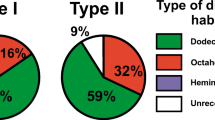Abstract
CARBONADOS are porous aggregates of micrometre-size diamond crystals1,2. Although they are not rare, they have not been found in kimberlites3, and they contain inclusion minerals typical of the Earth's crust, rather than the upper-mantle assemblages commonly found in kimberlite diamonds. Carbonados also have lower 13C/12C ratios than kimberlite diamonds1,2,4. Although these observations strongly suggest that carbonados were formed in the crust, crustal conditions are generally unlikely to provide pressures and temperatures in the diamond stability field (but see ref. 5 for a possible exception). Other suggestions for the origin of carbonado include the transformation of subducted carbon in the mantle6, impact metamorphism of crustal rocks containing organic carbon7, and (for very fine-grained carbonado) the irradiation of organic matter by decaying uranium and thorium in uranium-rich phases8–10. Here we present further evidence for a crustal connection, in the form of noble-gas data for four carbonados from Brazil and Africa. We find that all four contain large amounts of implanted xenon and krypton from 238U fission, nucleogenic neon and 4He, and tightly trapped atmospheric noble gases, from which we conclude that these carbonados formed in a uranium-rich crustal environment.
Similar content being viewed by others
References
Dawson, J. B. in The Properties of Diamond (ed. Field, J.) 539–554 (Academic, London, 1979).
Orlov, Yu. L. The Mineralogy of the Diamonds 17–19 (Wiley, New York, 1976).
Frantsesson, E. V. & Kaminskii, F. V. Dokl. Akad. Nauk SSSR 219, 187–189 (1975).
Sobolev, N. V. et al. Geologiya Geofiz. Novosibirsk 20, 3–19 (1989).
Sobolev, N. V. & Shatsky, V. S. Nature 343, 742–746 (1990).
Robinson, D. N. Miner. Sci. Engng 10, 55–72 (1978).
Smith, V. J. & Dawson, J. B. Geology 13, 342–343 (1985).
Kaminskii, F. V. Dokl. Akad. Nauk SSSR 294, 439–440 (1987).
Doinchuk, V. T. et al. Dokl. Akad. Nauk SSSR 231, 973–976 (1976).
Breger, I. A. in Proc. Symp. Formation of Uranium Ore Deposits 99–124 (IAEA, Vienna, 1974).
Wetherill, G. W. Phys. Rev. 92, 907–912 (1953).
Hebeda, E. H., Schultz, L. & Freundel, M. Earth planet. Sci. Lett. 85, 91–104 (1987).
Bigazzi, G. Earth planet Sci. Lett. 3, 434–438 (1967).
Denson, N. M. Bull. US geol. Surv. 1055, 1–10 (1959).
Allegre, C. J., Staudacher, T. & Sarda, P. Earth planet. Sci. Lett. 81, 127–150 (1986/7).
Ergun, S., Donaldson, W. F. & Breger, I. A. Fuel 39, 71–77 (1974).
Author information
Authors and Affiliations
Rights and permissions
About this article
Cite this article
Ozima, M., Zashu, S., Tomura, K. et al. Constraints from noble-gas contents on the origin of carbonado diamonds. Nature 351, 472–474 (1991). https://doi.org/10.1038/351472a0
Received:
Accepted:
Issue Date:
DOI: https://doi.org/10.1038/351472a0
- Springer Nature Limited
This article is cited by
-
Diamond and silicon carbide in impact melt rock from the Ries impact crater
Nature (1995)
-
Diamonds everywhere
Nature (1995)
-
Laser-induced luminescence from natural polycrystal diamond, ?Carbonado?
Naturwissenschaften (1991)





